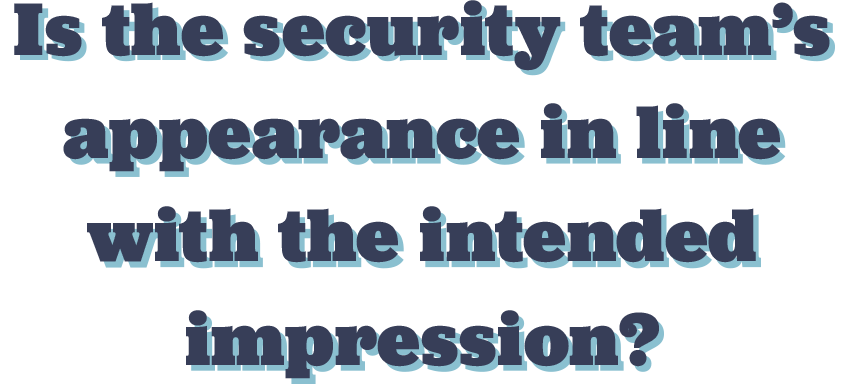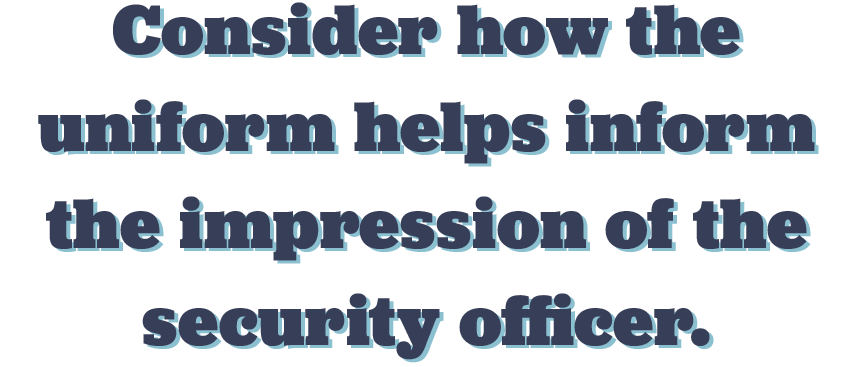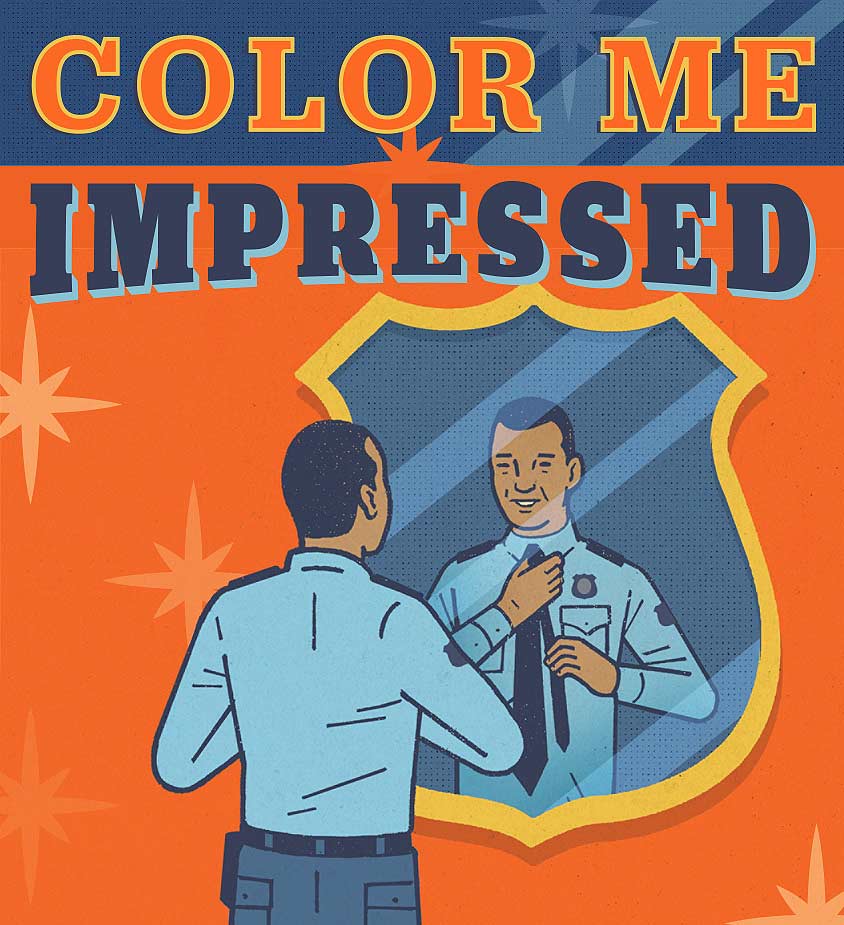Parsing the First Impressions of a Security Operation
Many security leaders tout the importance of excellent customer service, and guard force managers are frequently tasked with ensuring that their officers are on point. But how many security managers have ever taken a moment to look behind the curtain and examine the psychology of first impressions?
Understanding first impressions is invaluable in the field of security operations. Frontline security officers are often the very first salespeople for businesses, so their appearance and body language are both key. And the psychology of first impressions also applies to physical spaces, which may set the tone for user experience even before the client walks through the front door.
Yet despite their importance, first impressions in security operations are often underestimated and misunderstood by leadership.
Lightning Fast, Yet Weighty
A common axiom that circulated for years held that an individual has seven seconds to make a good first impression when meeting someone. However, the latest psychological research reduces the seven-second window considerably. In fact, scholars like Alexander Todorov argue that it takes only one-tenth of a second to establish a first impression.
In his book Face Value: The Irresistible Influence of First Impressions, Todorov describes a study in which participants were shown face photos of two actual (but unknown to the participants) political candidates in a real election. The participants were asked to decide which face looks more “competent.” Most chose the same face—they seemed to agree on what “competence” looks like.
Moreover, this judgment of perceived competence was also a largely successful predictor of who would win the election. The candidate whose face most people saw as “competent” also turned out to be the election winner. Essentially, the study illustrated Todorov’s theory—within one-tenth of a second, individuals make a judgment about a person’s competence, intelligence, and trustworthiness, and that judgment affects the way they make decisions.
This does not mean that first impressions are necessarily accurate. However, the brain makes these assumptions at lightning speed based on what information is immediately available. Given this, it seems only natural to ask: how much weight do first impressions carry?
Let’s take a quick look at a U.S. president to answer this question. In Malcolm Gladwell’s book Blink: The Power of Thinking Without Thinking, the author explains how Warren G. Harding, the 29th president of the United States, started his political career with a great first impression—one that went way beyond the example of competence cited earlier in this article.

“Many people who looked at Warren Harding saw how extraordinarily handsome and distinguished-looking he was and jumped to the immediate—and entirely unwarranted—conclusion that he was a man of courage and intelligence and integrity,” Gladwell writes. Ultimately, Harding turned out to be a bad president, according to majority consensus; history has assessed him to be corrupt and incapable. The lesson here is that regardless of whether a first impression is accurate, it can be very powerful.
Why do we give so much weight to our first impressions? In The Art of Thinking Clearly, author Rolf Dobelli explains that this phenomenon of making substantial judgments based on a first impression is called the halo effect. “The halo effect occurs,” Dobelli writes, “when a single aspect dazzles us and affects how we see the full picture.
In the case of Harding, voters were so impressed by his dazzling physical presence that they attributed several admirable qualities to him. “The halo effect increases the weight of first impressions, sometimes to the point that subsequent information is mostly wasted,” writes Daniel Kahneman in his book Thinking, Fast and Slow.
Thus, even if the first impression is wrong, it carries great weight. It has sticking power; it is difficult to dislodge. Effectively, if you make a bad first impression, it may take a disproportionate amount of time and effort to reverse the negative effects.
The Formation of Security Impressions
The speed and weight of first impressions come into play in the context of corporate security. Think of all the interactions security staff may have with employees, clients, and visitors. In the security operations world, interactions are often very short, sometimes involving little to no conversation. Yet impressions are quickly forming.
Let’s start at a front gate, where vehicles enter a corporate campus. An employee pulls up, looks at the officer, produces a badge, and keeps driving.
The research shows us that, even with less than a second’s worth of interaction, the employee will likely make a range of judgments about that security officer, and potentially make even broader assumptions about the entire corporate security team of the company. Those impressions may or may not be accurate, but research shows us that these judgments will likely be lasting ones.
Given all this, it is fair to assume that most security leaders would like for that first impression to be a positive one. Especially when one considers the strategic importance of first impressions in various key situations.
For example, imagine a scenario where a company is looking to hire a senior-level executive for a crucial role. Looking for the cream of the crop, the firm conducts a national search, with interviews held at the corporate headquarters. When the candidates arrive at the campus, the first person they meet is the uniformed security officer at the front gate. Imagine the ripple effect of a positive or negative first impression of that officer.
Now, imagine the company is also hosting a prospective client at the same campus, with a major sales deal on the line. The client faces the same first impression experience at the front gate, with the same gate officer. A negative first impression could hurt the deal’s chances for success.
Impression Ingredients
In sum, if security personnel are literally on the front lines of the business, it is critically important that they make the best impression possible. But what goes into an impression?
The easiest way to approach this topic is by distinguishing between impressions of people and places. In the context of corporate security, various people may represent a security team, from frontline officers to leaders who represent the corporate security function in board meetings, sales meetings, and audits.
However, first impressions extend beyond person-to-person interactions. Physical spaces and components thereof—like front lobbies, perimeter fences, or even lighting—can contribute to a first impression of a brand or company location.
Start by understanding some key ingredients to the “people” side of first impressions.
Uniform messages. What should security officers’ uniforms look like? The answer is more important than you might think.
There is a surprising amount of research devoted to the psychological effect of uniform color. In an article in Made to Measure, The Uniform Magazine, Bernadette Doran explains how different colors can directly affect moods. Black uniforms, for example, are associated with “anger, hostility, dominance, and aggression.”
In the article, Doran discusses a study in which participants were shown a variety of potential police uniforms then graded them as good or bad, nice or mean, and in a variety of other ways. “The all-black color scheme was viewed most negatively on six of the seven scales,” Doran writes, “and the light blue shirt and navy blue pants created the most positive impression on all seven scales.”
In the corporate security context, when a visitor encounters a front gate guard, a security receptionist, a foot patrol officer, or a guard force commander, usually one of the first things noticed is the uniform, if one is being worn. Managers should consider how the uniform helps inform the impression of the security officer. Does it make the officer seem friendly and approachable, or aggressive and intimidating? And whatever the effect, does it match the intended image of the operation?

For example, it may be appropriate and consistent for uniforms at a top-secret nuclear weapons testing facility to be more on the intimidating side. But the security department at a Fortune 500 corporate headquarters complex might want to convey a more welcoming and friendly impression.
Is the security team’s appearance in line with the intended impression? Security leaders can gain additional insight by asking core stakeholders how the security team’s appearance can contribute to the intended impression of the office and operation overall. Strive for message consistency: If stakeholders want to project a friendly and welcoming environment, black-on-black uniforms should likely be avoided. Something as simple as the color of a shirt can be more impactful than many assume.
Body language. Most security leaders know quite a bit about body language. Investigators often rely on body language to help determine if someone is being truthful, deceptive, or just nervous. Body language is just as important when it comes to informing a first impression.
According to a study by UCLA professor Albert Mehrabian, body language is the single most powerful piece of information for the creation of a first impression. In fact, according to research, 55 percent of the impression is derived from body language and appearance, 38 percent from the person’s voice, and 7 percent from the person’s language.
For example, a security officer is standing at the gate in a neatly pressed blue uniform. A visitor pulls up to the front gate to check in for a meeting on campus. The visitor cheerfully says, “Good morning, officer!” The officer, with arms crossed and eyes looking at a computer screen, quietly says, “Good morning,” with a serious face and pursed lips.
Think about how quickly this first impression has gone downhill. In the same interaction, different body language and tone of voice could have reversed the first impression. In that scenario, the officer’s arms aren’t crossed, he is making direct eye contact with the visitor, and he cheerfully says “Good morning” with a smile on his face. In an interaction that lasts for less than seven seconds, body language and tone of voice are absolutely crucial in determining the nature of the first impression.
A Sense of Place
A prime example of location-based first impressions is familiar to most homebuyers: “curb appeal.” In an article on the Dig This Design online publication, Susan Daniels says this about the concept: “Improving the exterior of your home with paint or new siding goes a long way towards making great first impressions.”
Of course, making a bad first impression is also possible. As Daniels explains, “In any form, clutter makes your property look uninviting. Any passerby looking at the property will look away if it’s cluttered.” Like first impressions of people, first impressions of physical spaces can be made quickly and be based on limited observation. Just as with people, the first impression of a place may or may not be accurate, but it nonetheless influences judgments and decisions.
In a security context, certain design and architectural decisions, such as perimeter fencing and guard houses, can have a direct impact. Security professionals often capitalize on these features so that they will have a deterrent effect in the crucial first impression phase.
But this effect can be taken to another level. The design of lobbies and workspaces can also have a direct emotional and psychological impact on those who use them, from the moment of entrance. That impact also relates back to the perceived security of a place.
While security directors are not architects, it is still imperative to spend time on determining where design, architecture, and security intersect, and to be mindful about that intersection point.
Luckily, there is plenty of research to educate us about this intersection point. In the foreword of the book Inquiry by Design: Environment/Behavior/Neuroscience in Architecture, Interiors, Landscape, and Planning, John Eberhard writes, “We know now that certain levels of light and noise in neonatal care units can interfere with critical sensory development in premature infants. We know that specific features of their physical environment can support healthy behavior among people with Alzheimer’s disease.”
Such research makes it clear that physical spaces can and do have an impact on health and well-being. These spaces can also affect stress and anxiety levels.
Other types of physical spaces can also have calming effects, as researchers discovered in the Oregon prison system.
In her article “Using Nature Imagery to Calm Prisoners,” Janice Wood describes a unique experiment in Oregon in which nature videos were shown to a certain population of maximum-security prisoners during their daily exercise period. The results were impressive. According to Wood, “Inmates told researchers they felt calmer after watching the videos, with the calm emotions lasting for hours…. They also reported that they felt the videos helped improve their relationships with staff, and that remembering the videos helped them calm down when they were angry.”
Not only did the prisoners report on the positive emotional effects of the nature imagery, but there was also a measurable impact on behavior. The experiment results indicated that the prisoners who viewed the videos committed 26 percent fewer infractions than the prisoners who did not.
Other studies have also revealed the connection between physical design and mental health. This connection quickly links to risk factors that relate to violence at work. If a space can be designed with intentional calming effects in an effort to reduce stress, could this design also help decrease the likelihood of an act of workplace violence?
During design, new construction, or renovations, it behooves security professionals to think beyond the basics of fences and turnstiles. Those are indeed important, because they are an important part of a first impression for a visitor, client, or employee. But it is equally important to envision the entire office environment, and how it can help provide holistic and sustainable safety for all of those who enter.
Security leaders may not be architects, but they can still can add value to the planning and decision-making process by being able to articulate the connection between design and the ultimate goal of creating a safe place.
Takeaway Tips
The research cited above provides a few key takeaways that security managers can act on, almost immediately, to help leverage the power of the first impression.
Both body language and uniform color play a key role in forming a first impression. Given this, it is crucial to examine how frontline personnel are trained to portray themselves—verbally, visually, and with body language—when interacting with customers.
Similarly, teams should be empowered to examine all of the ways in which they interact with stakeholders.
Security leaders should take the time to interact with stakeholders and ask what the security team can do to further promote a welcoming, safe, and healthy environment. What type of work environment are site leaders hoping to provide to employees? Security professionals can seek ways to add value to that vision. This could be done through well-trained and well-informed personnel or through recommendations for physical designs that contribute to mental health and positive, long-lasting first impressions.
Burke Sigurdur Brownfeld is the director of security and global safety for Visa Inc. He also is an author, speaker, and documentary film producer, focusing on topics related to corporate security and criminal justice.
